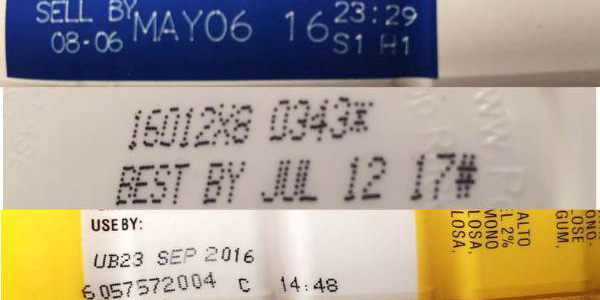As Vermont prepares for its GMO labeling law to take effect in July, another piece of important legislation is working its way into the spotlight: expiration date labeling. California Assemblyman David Chiu, D-San Francisco, is spearheading legislation (AB2725) that would require manufacturers to use one of just two labeling options in an effort to curb food waste and feed the hungry. Regardless of how you feel about government regulation, these two objectives are cause for conscious eaters to read on.
In the U.S., about 40 percent of our food goes to waste each year. And of that, about 97 percent (34 million tons) will end up in a landfill according to the Environmental Protection Agency (EPA). From there, it breaks down anaerobically, releasing methane gas into the atmosphere which is 21 times more potent as a greenhouse gas than CO2.
Meanwhile, according to Feeding America, 48.1 million Americans live in food insecure households, including 32.8 million adults and 15.3 million children. Healthcare costs resulting from hunger and food insecurity cost the U.S. economy about $160 billion a year.
One of the main drivers of food waste is confusion over expiration date labeling. You’ve probably wondered yourself what the difference is between “best by” and “sell by.” Not to mention the slew of other labels, including “use by,” “freshest by,” “best before,” “exp.,” “enjoy by,” and “expiration date.”
The under-publicized truth is that most of these dates are completely arbitrary. States often let the manufacturer or processor determine the timeframe. And as a group of Harvard students discovered, it usually has no correlation with safety and no scientific backing. For example, milk that lasts for 21 days will be labeled to expire in 12. This raises skepticism over intent—safety or more sales?
As Tara Duggan reports in her SF Gate article entitled “Food waste is target of legislation on expiration labels,” consumers regularly throw away expired food, much of which is safe. Yet, in some states, retailers and food banks cannot sell or donate food that has passed its “sell by” date.
Duggan’s piece includes commentary from Dana Gunders, staff scientist in the food and agriculture program at the Natural Resources Defense Council—a co-sponsor of Chiu’s bill. She states that: “Generally speaking, people don’t get sick from food because it’s aging. Instead, food makes people sick because it was contaminated with E. coli, salmonella or other pathogens—and time won’t make a difference in most cases.”
Chiu believes that addressing dating-label confusion will create situations that are better for consumers, businesses, the environment and those who deal with food insecurity day in and day out. His proposal would require manufacturers to use one of the two following labels:
- “Best if used by” to indicate when food quality will still be at its best, for example before crackers start to go soggy.
- “Expires on” to indicate the date after which highly perishable foods could be dangerous, especially food at risk for listeria.
According to the report “Rethink Food Waste Through Economics and Data,” standardizing expiration dates could divert approximately 398,000 tons of food from landfills. And as Duggan reports, food waste experts estimate that reducing food waste by 30 percent could feed every hungry American. It’s a no-brainer.

